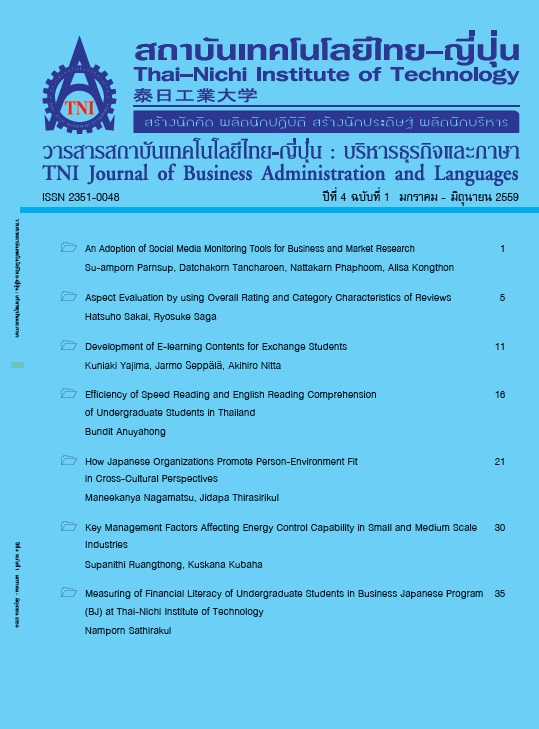Startups and the Growth of an Industrial Cluster
Main Article Content
Abstract
Cluster growth can be driven by established firms or startups. However, the pattern of the cluster growth in each case is different. This paper compares the pattern of clusters in a short run and long run between clusters that are driven by startups and clusters driven by established firms. The findings show that the number of startups in startup-driven clusters is lower than in the established-firm-driven clusters in a short run. However, in a long run, startup-driven clusters have more startups than the established-firm-driven clusters because innovative people in established-firm-driven clusters face a failure experience and are demotivated.
Article Details
Article Accepting Policy
The editorial board of Thai-Nichi Institute of Technology is pleased to receive articles from lecturers and experts in the fields of business administration, languages, engineering and technology written in Thai or English. The academic work submitted for publication must not be published in any other publication before and must not be under consideration of other journal submissions. Therefore, those interested in participating in the dissemination of work and knowledge can submit their article to the editorial board for further submission to the screening committee to consider publishing in the journal. The articles that can be published include solely research articles. Interested persons can prepare their articles by reviewing recommendations for article authors.
Copyright infringement is solely the responsibility of the author(s) of the article. Articles that have been published must be screened and reviewed for quality from qualified experts approved by the editorial board.
The text that appears within each article published in this research journal is a personal opinion of each author, nothing related to Thai-Nichi Institute of Technology, and other faculty members in the institution in any way. Responsibilities and accuracy for the content of each article are owned by each author. If there is any mistake, each author will be responsible for his/her own article(s).
The editorial board reserves the right not to bring any content, views or comments of articles in the Journal of Thai-Nichi Institute of Technology to publish before receiving permission from the authorized author(s) in writing. The published work is the copyright of the Journal of Thai-Nichi Institute of Technology.
References
M. E. Porter, “Clusters and the New Economics of Competition,” Harvard Business Review, vol. 76, pp. 77-90, 11 1998.
V. D. Norman and A. J. Venables, “Industrial Clusters: Equilibrium, Welfare and Policy,” Economica, vol. 71, pp. 543-558, 2004.
G. De Blasio and S. Di Addario, “Do Workers Benefit from Industrial Agglomeration?,” Journal of Regional Science, vol. 45, pp. 797-827, 2005.
D. Hallencreutz and P. E. R. Lundequist, “Spatial Clustering and the Potential for Policy Practice: Experiences from Cluster-building Processes in Sweden,” European Planning Studies, vol. 11, p. 533, 2003.
R. Kaiser, “Multi-level Science Policy and Regional Innovation: The Case of the Munich Cluster for Pharmaceutical Biotechnology,” European Planning Studies, vol. 11, pp. 841-857, 2003.
D. Learmonth, A. Munro, and J. K. Swales, “Multi-sectoral Cluster Modelling: The Evaluation of Scottish Enterprise Cluster Policy,” European Planning Studies, vol. 11, pp. 567-584, 2003.
T. Altenburg and J. Meyer-Stamer, “How to Promote Clusters: Policy Experiences from Latin America,” World Development, vol. 27, pp. 1693-1713, 1999.
W. B. Arthur, “Industry Location Patterns and the Importance of History,” in Increasing Returns and Path Dependence in the Economy, ed Ann Arbor: The University of Michigan Press, 1994, pp. 49-67.
M. P. Feldman and J. L. Francis, “Homegrown Solutions: Fostering Cluster Formation,” Economic Development Quarterly, vol. 18, pp. 127-137, May 1, 2004 2004.
M. E. Porter, Competitive Advantage of Nations. New York: Free Press, 1998.
T. Brenner, “Innovation and cooperation during the emergence of local industrial clusters:An empirical study in Germany,” European Planning Studies, vol. 13, pp. 921 - 938, 2005.
P. Intarakumnerd, N. Gerdsri, and P. Teekasap, “The roles of external knowledge sources in Thailand’s automotive industry,” Asian Journal of Technology Innovation, vol. 20, pp. 85-97, 2012.
M. E. Porter and O. Solvell, “Finland and Nokia: Creating the World’s Most Competitive Economy” Harvard Business Case, 2002.
T. Khanna and K. G. Palepu, “Emerging Giants,” Harvard Business Review, vol. 84, pp. 60-69, 10 2006.
J. D. Sterman, Business Dynamics : Systems Thinking and Modeling for a Complex World. Boston: Irwin/McGraw-Hill, 2000.
J. D. W. Morecroft, D. C. Lane, and P. S. Viita, “Modelling Growth Strategy in a Biotechnology Startup Firm,” System Dynamics Review, vol. 7, pp. 93-116, 1991.
J. W. Forrester, Industrial Dynamics. Waltham, MA: Pegasus Communications, 1999.
J. D. W. Morecroft, Strategic Modelling and Business Dynamics: A Feedback Systems Approach Chichester: Wiley 2007.
K. D. Warren, Competitive Strategy Dynamics, Hardback ed. United Kingdom: Wiley, 2002.
H. B. Weil, “Application of system dynamics to corporate strategy: an evolution of issues and frameworks,” System Dynamics Review, vol. 23, pp. 137-156, Summer/Fall 2007.


